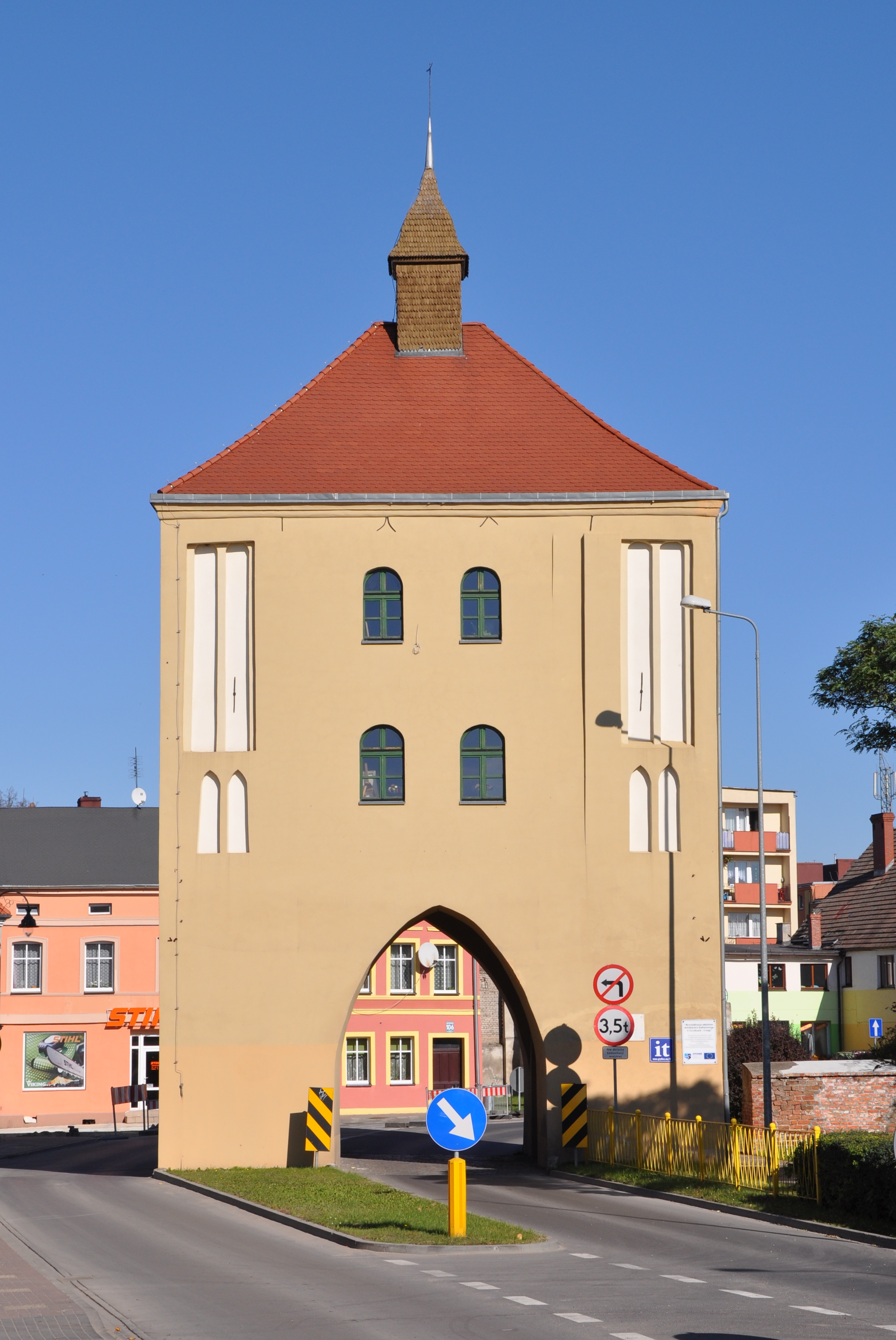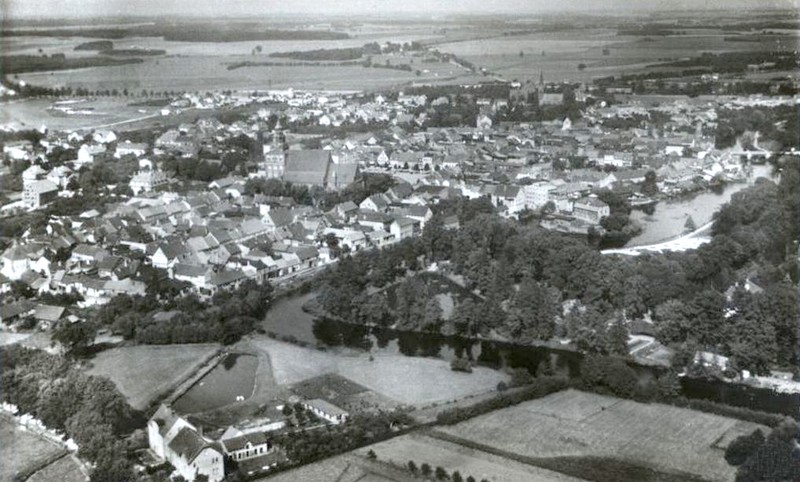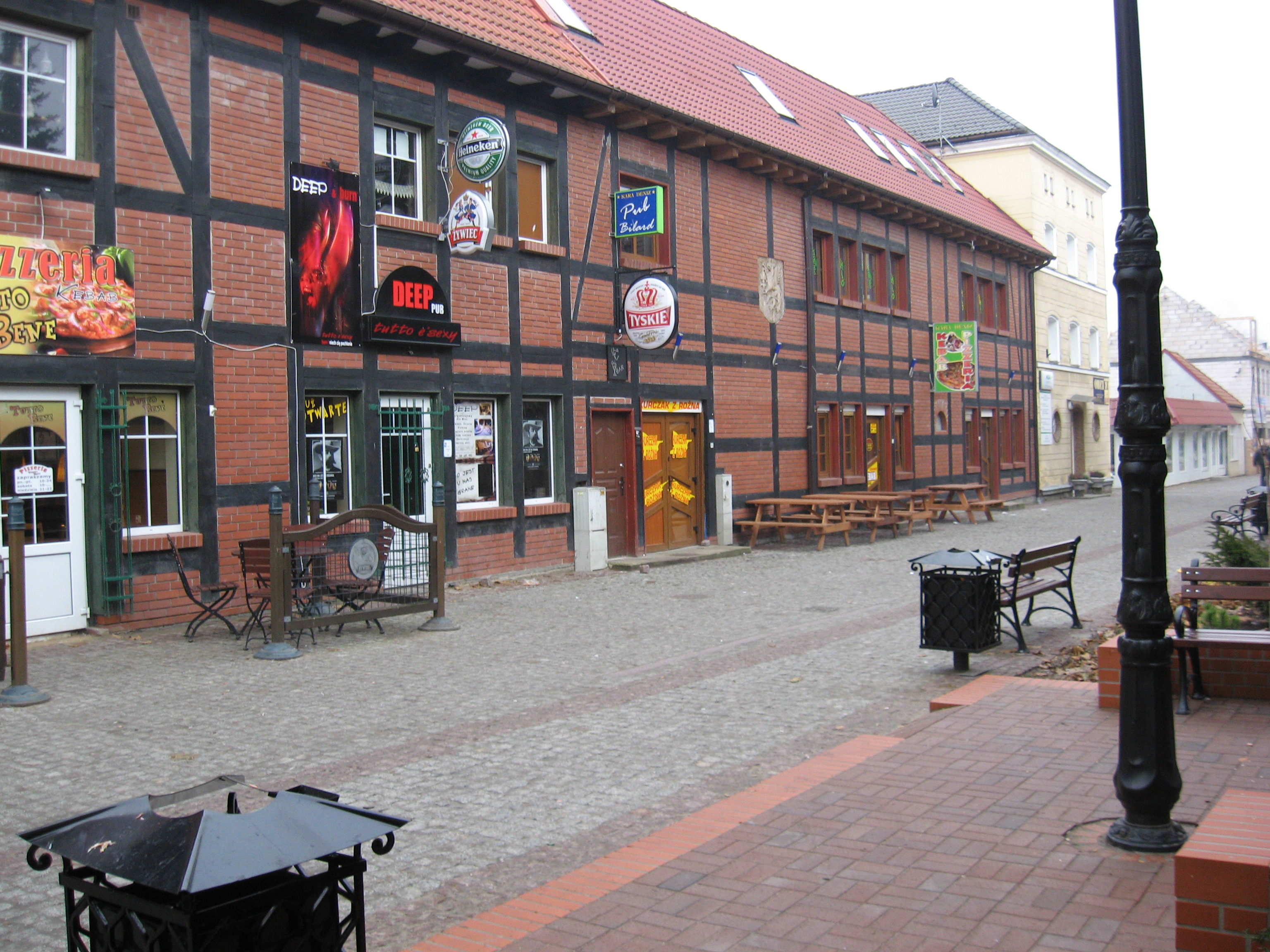Gryfice on:
[Wikipedia]
[Google]
[Amazon]
Gryfice (pronounced ; Kashubian: ''Grëfice''; formerly german: Greifenberg)". 1880. is a historic town in
 The region was part of Poland during the reign of the first Polish rulers
The region was part of Poland during the reign of the first Polish rulers
 In 1894 the town was connected to the railway line Dąbie (Altdamm) - Kołobrzeg (Kolberg). On July 1, 1896 the Greifenberger Kleinbahn was opened, a narrow-gauge railway today used as a railway Museum. In 1933 a Polish association of agricultural workers was established in Gryfice. Local
In 1894 the town was connected to the railway line Dąbie (Altdamm) - Kołobrzeg (Kolberg). On July 1, 1896 the Greifenberger Kleinbahn was opened, a narrow-gauge railway today used as a railway Museum. In 1933 a Polish association of agricultural workers was established in Gryfice. Local  After the war, the life of the town was being rebuilt. In 1945, the first post-war schools, a hospital and a cinema were opened and the following year a mill, a
After the war, the life of the town was being rebuilt. In 1945, the first post-war schools, a hospital and a cinema were opened and the following year a mill, a 


ImageSize = width:530 height:220
PlotArea = left:70 right:40 top:20 bottom:20
TimeAxis = orientation:vertical
AlignBars = justify
Colors =
id:gray1 value:gray(0.9)
DateFormat = yyyy
Period = from:0 till:18100
ScaleMajor = unit:year increment:2000 start:0 gridcolor:gray1
PlotData =
bar:1939 color:gray1 width:1
from:0 till:10817 width:15 text:10,8 textcolor:red fontsize:8px
bar:1946 color:gray1 width:1
from:0 till:4898 width:15 text:4,9 textcolor:red fontsize:8px
bar:1950 color:gray1 width:1
from:0 till:8737 width:15 text:8,7 textcolor:red fontsize:8px
bar:1955 color:gray1 width:1
from:0 till:10320 width:15 text:10,3 textcolor:red fontsize:8px
bar:1960 color:gray1 width:1
from:0 till:11548 width:15 text:11,6 textcolor:red fontsize:8px
bar:1965 color:gray1 width:1
from:0 till:12290 width:15 text:12,3 textcolor:red fontsize:8px
bar:1970 color:gray1 width:1
from:0 till:13175 width:15 text:13,2 textcolor:red fontsize:8px
bar:1975 color:gray1 width:1
from:0 till:13939 width:15 text:13,9 textcolor:red fontsize:8px
bar:1980 color:gray1 width:1
from:0 till:15239 width:15 text:15,3 textcolor:red fontsize:8px
bar:1985 color:gray1 width:1
from:0 till:16523 width:15 text:16,5 textcolor:red fontsize:8px
bar:1990 color:gray1 width:1
from:0 till:17593 width:15 text:17,6 textcolor:red fontsize:8px
bar:1995 color:gray1 width:1
from:0 till:18078 width:15 text:18,1 textcolor:red fontsize:8px
bar:2000 color:gray1 width:1
from:0 till:17244 width:15 text:17,3 textcolor:red fontsize:8px
bar:2005 color:gray1 width:1
from:0 till:16850 width:15 text:16,9 textcolor:red fontsize:8px
online
.
Official website
Jewish Community in Gryfice
on Virtual Shtetl {{Authority control Cities and towns in West Pomeranian Voivodeship Gryfice County
Pomerania
Pomerania ( pl, Pomorze; german: Pommern; Kashubian: ''Pòmòrskô''; sv, Pommern) is a historical region on the southern shore of the Baltic Sea in Central Europe, split between Poland and Germany. The western part of Pomerania belongs to ...
, north-western Poland
Poland, officially the Republic of Poland, is a country in Central Europe. It is divided into 16 administrative provinces called voivodeships, covering an area of . Poland has a population of over 38 million and is the fifth-most populou ...
, with 16,600 inhabitants (2017). It is the capital of Gryfice County in West Pomeranian Voivodeship
The West Pomeranian Voivodeship, also known as the West Pomerania Province, is a voivodeship (province) in northwestern Poland. Its capital and largest city is Szczecin. Its area equals 22 892.48 km² (8,838.84 sq mi), and in 2021, it was ...
(since 1999), previously in Szczecin Voivodeship (1975–1998). The town is situated approximately 22 kilometres from the Baltic Sea
The Baltic Sea is an arm of the Atlantic Ocean that is enclosed by Denmark, Estonia, Finland, Germany, Latvia, Lithuania, Poland, Russia, Sweden and the North and Central European Plain.
The sea stretches from 53°N to 66°N latitude and from ...
coast and seaside resorts.
History
Middle Ages
 The region was part of Poland during the reign of the first Polish rulers
The region was part of Poland during the reign of the first Polish rulers Mieszko I
Mieszko I (; – 25 May 992) was the first ruler of Poland and the founder of the first independent Polish state, the Duchy of Poland. His reign stretched from 960 to his death and he was a member of the Piast dynasty, a son of Siemomysł and ...
and Bolesław I the Brave
Bolesław I the Brave ; cs, Boleslav Chrabrý; la, Boleslaus I rex Poloniae (17 June 1025), less often known as Bolesław the Great, was Duke of Poland from 992 to 1025, and the first King of Poland in 1025. He was also Duke of Bohemia betwe ...
. The Battle of Niekładź took place in the area of Gryfice in 1121, in which Polish ruler Bolesław III Wrymouth
Bolesław III Wrymouth ( pl, Bolesław III Krzywousty; 20 August 1086 – 28 October 1138), also known as Boleslaus the Wry-mouthed, was the duke of Lesser Poland, Silesia and Sandomierz between 1102 and 1107 and over the whole of Poland between ...
defeated Wartislaw I, Duke of Pomerania
Wartislaw I (''Warcisław I'') (around 1092 – August 9, 1135) was the first historical ruler of the Duchy of Pomerania and the founder of the Griffin dynasty.
Most of the information about him comes from the writings on the life of Otto of Ba ...
and Swantopolk I, Duke of Pomerania. The area was part of the Duchy of Pomerania
The Duchy of Pomerania (german: Herzogtum Pommern; pl, Księstwo Pomorskie; Latin: ''Ducatus Pomeraniae'') was a duchy in Pomerania on the southern coast of the Baltic Sea, ruled by dukes of the House of Pomerania (''Griffins''). The country ha ...
, a vassal state of Poland
Poland, officially the Republic of Poland, is a country in Central Europe. It is divided into 16 administrative provinces called voivodeships, covering an area of . Poland has a population of over 38 million and is the fifth-most populou ...
, which later on separated itself from Poland as a result of the fragmentation of Poland
The period of rule by the Piast dynasty between the 10th and 14th centuries is the first major stage of the history of the Polish state. The dynasty was founded by a series of dukes listed by the chronicler Gall Anonymous in the early 12th cen ...
.
In 1262 Wartislaw III, Duke of Pomerania founded a town under Lübeck law
The Lübeck law (german: Lübisches (Stadt)Recht) was the family of codified municipal law developed at Lübeck, which became a free imperial city in 1226 and is located in present day Schleswig-Holstein. It was the second most prevalent form o ...
on the Rega river to attract German settlers. After his death, his successor, Barnim I, Duke of Pomerania, named the settlement ''Civitat Griphemberch super Regam'' (Middle High German
Middle High German (MHG; german: Mittelhochdeutsch (Mhd.)) is the term for the form of German spoken in the High Middle Ages. It is conventionally dated between 1050 and 1350, developing from Old High German and into Early New High German. Hig ...
'Griphemberch' meaning Griffin's mountain) after the coat of arms symbol of the Dukes of Pomerania. In 1365 the town entered the Hanseatic League
The Hanseatic League (; gml, Hanse, , ; german: label= Modern German, Deutsche Hanse) was a medieval commercial and defensive confederation of merchant guilds and market towns in Central and Northern Europe. Growing from a few North German to ...
and prospered due to the right of free navigation on the Rega.
A town wall was built and at the end of the 13th century the construction of the St. Mary's church was begun. In a document of 1386 a Latin school is mentioned, which is generally called the oldest in Pomerania.
Modern era
In the 16th century, the local Germans pursued a policy ofGermanisation
Germanisation, or Germanization, is the spread of the German language, people and culture. It was a central idea of German conservative thought in the 19th and the 20th centuries, when conservatism and ethnic nationalism went hand in hand. In lin ...
towards the indigenous population, which, however, did not bring results quickly. At that time, some of the indigenous peasants fled to Poland
Poland, officially the Republic of Poland, is a country in Central Europe. It is divided into 16 administrative provinces called voivodeships, covering an area of . Poland has a population of over 38 million and is the fifth-most populou ...
, while Scottish immigrants settled in the town. As a result of the Thirty Years' War
The Thirty Years' War was one of the longest and most destructive conflicts in European history, lasting from 1618 to 1648. Fought primarily in Central Europe, an estimated 4.5 to 8 million soldiers and civilians died as a result of batt ...
, the population of the town decreased dramatically. The town was occupied by the Imperial
Imperial is that which relates to an empire, emperor, or imperialism.
Imperial or The Imperial may also refer to:
Places
United States
* Imperial, California
* Imperial, Missouri
* Imperial, Nebraska
* Imperial, Pennsylvania
* Imperial, Texas
...
and Swedish armies. After the death of the last Pomeranian Duke and by the Treaty of Westphalia
The Peace of Westphalia (german: Westfälischer Friede, ) is the collective name for two peace treaties signed in October 1648 in the Westphalian cities of Osnabrück and Münster. They ended the Thirty Years' War (1618–1648) and brought ...
Greifenberg became part of Brandenburg-Prussia
Brandenburg-Prussia (german: Brandenburg-Preußen; ) is the historiographic denomination for the early modern realm of the Brandenburgian Hohenzollerns between 1618 and 1701. Based in the Electorate of Brandenburg, the main branch of the Hohe ...
in 1648 and part of Imperial Germany
The German Empire (),Herbert Tuttle wrote in September 1881 that the term "Reich" does not literally connote an empire as has been commonly assumed by English-speaking people. The term literally denotes an empire – particularly a hereditary ...
in 1871. In 1818 the town became the capital of the Greifenberg district (Kreis Greifenberg).
 In 1894 the town was connected to the railway line Dąbie (Altdamm) - Kołobrzeg (Kolberg). On July 1, 1896 the Greifenberger Kleinbahn was opened, a narrow-gauge railway today used as a railway Museum. In 1933 a Polish association of agricultural workers was established in Gryfice. Local
In 1894 the town was connected to the railway line Dąbie (Altdamm) - Kołobrzeg (Kolberg). On July 1, 1896 the Greifenberger Kleinbahn was opened, a narrow-gauge railway today used as a railway Museum. In 1933 a Polish association of agricultural workers was established in Gryfice. Local Poles
Poles,, ; singular masculine: ''Polak'', singular feminine: ''Polka'' or Polish people, are a West Slavic nation and ethnic group, who share a common history, culture, the Polish language and are identified with the country of Poland in ...
and Jews
Jews ( he, יְהוּדִים, , ) or Jewish people are an ethnoreligious group and nation originating from the Israelites Israelite origins and kingdom: "The first act in the long drama of Jewish history is the age of the Israelites""The ...
were subjected to increased repressions, after the Nazis
Nazism ( ; german: Nazismus), the common name in English for National Socialism (german: Nationalsozialismus, ), is the far-right totalitarian political ideology and practices associated with Adolf Hitler and the Nazi Party (NSDAP) in N ...
came to power in Germany in 1933. After the German invasion of Poland
The invasion of Poland (1 September – 6 October 1939) was a joint attack on the Republic of Poland by Nazi Germany and the Soviet Union which marked the beginning of World War II. The German invasion began on 1 September 1939, one week af ...
, forced labourers from Poland were brought to the town.K. Golczewski, ''Miasto Gryfice i powiat na przełomie lat 1944-1945'', p. 60-61 (in Polish)
At the end of World War II
World War II or the Second World War, often abbreviated as WWII or WW2, was a world war that lasted from 1939 to 1945. It involved the World War II by country, vast majority of the world's countries—including all of the great power ...
, on March 5, 1945, the Soviet Red Army
The Workers' and Peasants' Red Army (Russian language, Russian: Рабо́че-крестья́нская Кра́сная армия),) often shortened to the Red Army, was the army and air force of the Russian Soviet Federative Socialist R ...
conquered the town, and on March 8, Poles entered the town. Approximately 40 percent of the town was destroyed, however many historical monuments stayed intact or were reconstructed. Following the post-war boundary changes, the town became part of Poland. Initially called ''Zagórze'', it was eventually given the Polish name ''Gryfice''. The Germans who did not escape during the battle with the Soviets, were expelled and the town was populated with Poles
Poles,, ; singular masculine: ''Polak'', singular feminine: ''Polka'' or Polish people, are a West Slavic nation and ethnic group, who share a common history, culture, the Polish language and are identified with the country of Poland in ...
, some of them expellees themselves from Polish areas annexed by the Soviet Union. The post-war administration of Gryfice was created with the participation of the just freed Polish forced labourers.
 After the war, the life of the town was being rebuilt. In 1945, the first post-war schools, a hospital and a cinema were opened and the following year a mill, a
After the war, the life of the town was being rebuilt. In 1945, the first post-war schools, a hospital and a cinema were opened and the following year a mill, a gasworks
A gasworks or gas house is an industrial plant for the production of flammable gas. Many of these have been made redundant in the developed world by the use of natural gas, though they are still used for storage space.
Early gasworks
Coal ...
and a marmalade factory were opened. In 1948 a sugar factory
A sugar refinery is a refinery which processes raw sugar from cane or beets into white refined sugar.
Many cane sugar mills produce raw sugar, which is sugar that still contains molasses, giving it more colour (and impurities) than the white ...
was established, which already in 1951 was one of the leading sugar factories in Poland.



Demographics
Between its foundation and 1945, Greifenberg was predominantly inhabited by German-speaking people. By the 18th century, almost all inhabitants where Lutheran Protestants, with small Jewish and Catholic minorities. With the expropriation and expulsion of the German inhabitants at the end of World War II and the occupation of the vacated buildings by Polish settlers, the majority of its population has been composed ofRoman Catholics
The Catholic Church, also known as the Roman Catholic Church, is the largest Christian church, with 1.3 billion baptized Catholics worldwide . It is among the world's oldest and largest international institutions, and has played a ...
.
Notable residents
*David Christiani
David Christiani (25 December 1610 – 13 February 1688) was a German mathematician, philosopher and Lutheran theologian. He became an ordinary professor of mathematics at the University of Marburg in 1643, ordinary professor of theology at the U ...
(1610–1688), a German mathematician, philosopher and Lutheran theologian
* Karl Wilhelm Gottlob Kastner
Karl Wilhelm Gottlob Kastner (31 October 1783 – 13 July 1857) was a German chemist, natural scientist and a professor of physics and chemistry.
Biography
Kastner received his doctorate in 1805 under the guidance of Johann Göttling and began ...
, (1783–1857) a German chemist, natural scientist and a professor of physics and chemistry
* Gustav von Struensee (1803–1875) a German writer.
* Herman Schatz (1843–1906) an American politician and blacksmith emigrated to the US in 1851
* Friedrich Heinrich Albert Wangerin (1844–1933) a German mathematician.
* Richard C. H. Lenski (1864−1936), Lutheran scholar, emigrated to the US in 1872
* Conrad Pochhammer (1873–1932) a German physician and surgeon
* Rita von Gaudecker (1879–1968) a German author of books for children and young people
* Moritz Seeler (1896–1942) a German poet, writer, film producer and victim of the Holocaust.
* Ehrengard Schramm (1900–1985) a German politician and writer
* Krzysztof Linkowski (born 1949) a retired Polish runner who specialized in the 800 metres
* Bartosz Nowicki (born 1984) a Polish middle distance runner.
* Grzegorz Krychowiak
Grzegorz Krychowiak (; born 29 January 1990) is a Polish professional footballer who plays as a defensive midfielder for Saudi Arabian club Al-Shabab, on loan from Krasnodar, and the Poland national team.
Beginning his senior career in France ...
(born 1990) a Polish professional football player.
International relations
Twin towns — Sister cities
Gryfice is twinned with: * Güstrow, Germany * Meldorf, Germany * Gryfów Śląski, PolandNotes
Literature
*Gustav Kratz
Gustav, Gustaf or Gustave may refer to:
*Gustav (name), a male given name of Old Swedish origin
Art, entertainment, and media
*Primeval (film), ''Primeval'' (film), a 2007 American horror film
*Gustav (film series), ''Gustav'' (film series), a Hu ...
: ''Die Städte der Provinz Pommern - Abriß ihrer Geschichte, zumeist nach Urkunden''. Berlin 1865 (reprinted in 1996 by Sändig Reprint Verlag, Vaduz/Liechtenstein, ; reprinted in 2011 by Kessinger Publishing
Kessinger Publishing LLC is an American print-on-demand publishing company located in Whitefish, Montana, that specializes in rare, out-of-print books. According to Kelly Gallagher, vice president of publishing services at a bibliographic inform ...
, U.S.A., ), pp. 32–38online
.
External links
Official website
Jewish Community in Gryfice
on Virtual Shtetl {{Authority control Cities and towns in West Pomeranian Voivodeship Gryfice County